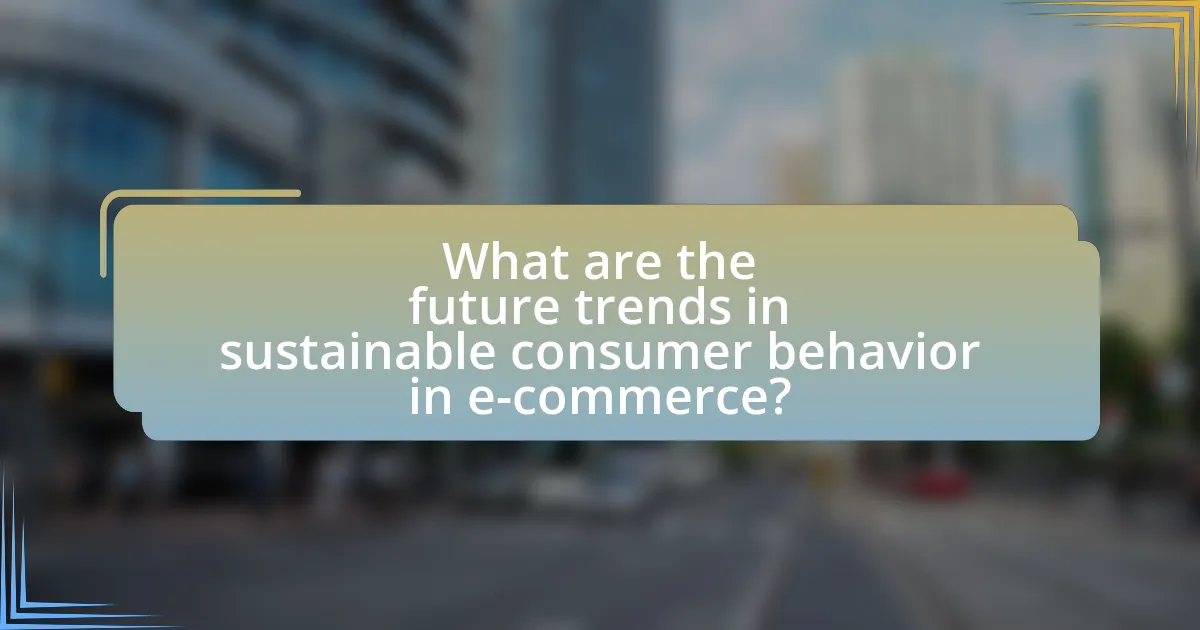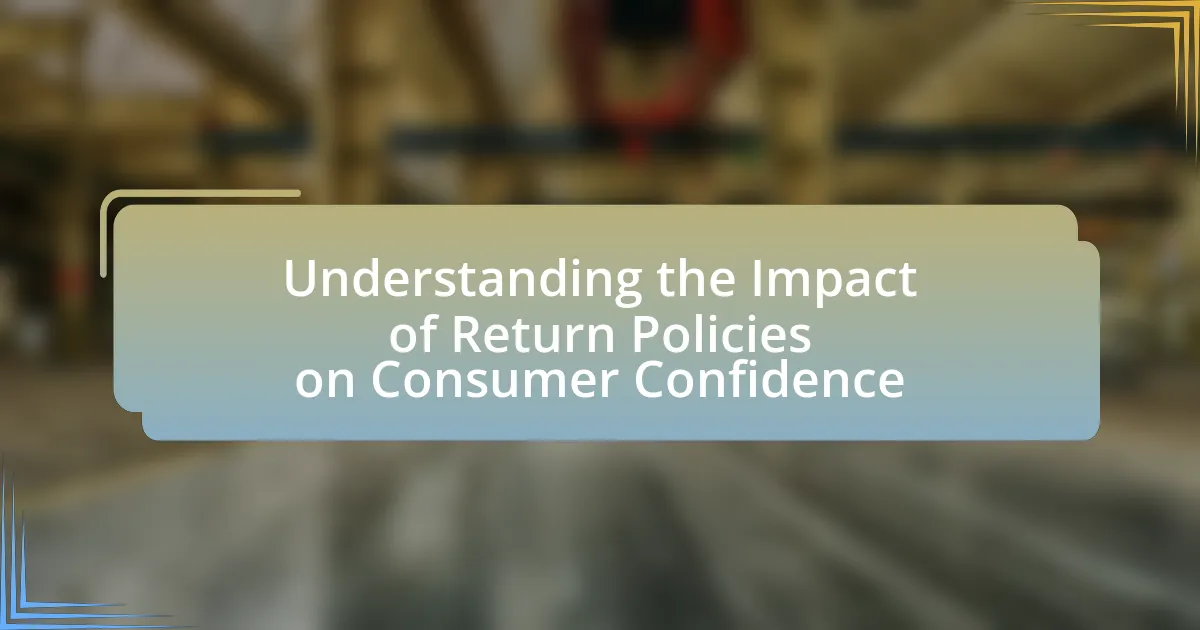The article examines the shift towards sustainable consumer behavior in e-commerce, highlighting the increasing preference for environmentally friendly products and practices among consumers. Key findings indicate that a significant portion of global consumers are willing to pay more for sustainable brands, driven by heightened environmental awareness and social responsibility. The article explores factors influencing this shift, including demographic changes, the role of technology, and the impact of regulatory frameworks. Additionally, it addresses the challenges consumers face in adopting sustainable practices and outlines best practices for e-commerce businesses to enhance sustainability and effectively communicate their efforts to consumers.

What is the Shift Towards Sustainable Consumer Behavior in E-commerce?
The shift towards sustainable consumer behavior in e-commerce refers to the increasing preference of consumers for environmentally friendly products and practices when shopping online. This trend is driven by heightened awareness of environmental issues, with studies indicating that 66% of global consumers are willing to pay more for sustainable brands, according to a Nielsen report. Additionally, e-commerce platforms are responding by implementing sustainable practices, such as reducing packaging waste and offering eco-friendly product options, which further aligns with consumer demand for sustainability.
How has consumer behavior evolved in the context of sustainability?
Consumer behavior has evolved significantly in the context of sustainability, with a marked increase in demand for eco-friendly products and practices. This shift is evidenced by a 2021 survey from McKinsey, which found that 70% of consumers are willing to pay more for sustainable products, reflecting a growing awareness of environmental issues. Additionally, brands that prioritize sustainability are experiencing higher customer loyalty, as consumers increasingly prefer companies that align with their values. This evolution is further supported by the rise of social media, where consumers actively share their sustainability preferences, influencing others and driving market trends.
What factors have influenced this shift in consumer preferences?
The shift in consumer preferences towards sustainable behavior in e-commerce has been influenced by several key factors, including increased environmental awareness, social responsibility, and the impact of social media. Increased environmental awareness has led consumers to prioritize eco-friendly products, as evidenced by a 2021 survey indicating that 73% of consumers are willing to change their consumption habits to reduce environmental impact. Social responsibility has also played a significant role, with brands that demonstrate ethical practices gaining consumer trust and loyalty. Additionally, social media platforms have amplified the visibility of sustainability issues, encouraging consumers to support brands that align with their values. These factors collectively drive the trend towards sustainable consumer behavior in e-commerce.
How do demographic changes impact sustainable consumer behavior?
Demographic changes significantly impact sustainable consumer behavior by influencing purchasing decisions and preferences. For instance, younger generations, such as Millennials and Gen Z, prioritize sustainability more than older generations, leading to increased demand for eco-friendly products. According to a 2021 survey by Nielsen, 73% of Millennials are willing to pay more for sustainable offerings, highlighting a shift in consumer values driven by demographic factors. Additionally, urbanization trends often correlate with higher awareness of environmental issues, as urban consumers typically have greater access to information and sustainable options. This demographic shift towards younger, urban populations is reshaping market dynamics, compelling businesses to adopt sustainable practices to meet evolving consumer expectations.
Why is sustainability important in the e-commerce sector?
Sustainability is important in the e-commerce sector because it addresses environmental concerns and meets consumer demand for responsible practices. E-commerce contributes significantly to carbon emissions through packaging, shipping, and energy consumption; thus, adopting sustainable practices can reduce these impacts. For instance, a study by McKinsey & Company found that sustainable supply chain practices can reduce greenhouse gas emissions by up to 30%. Additionally, consumers increasingly prefer brands that demonstrate environmental responsibility, with 66% of global consumers willing to pay more for sustainable products, according to Nielsen. This shift not only enhances brand loyalty but also drives competitive advantage in a crowded market.
What are the environmental impacts of traditional e-commerce practices?
Traditional e-commerce practices significantly contribute to environmental impacts, primarily through increased carbon emissions, excessive packaging waste, and heightened energy consumption. The logistics involved in shipping products directly to consumers often require extensive transportation networks, which are responsible for approximately 29% of global greenhouse gas emissions from freight transport. Additionally, the reliance on single-use packaging materials leads to substantial waste; for instance, the e-commerce sector generated an estimated 30 million tons of plastic waste in 2020 alone. Furthermore, the energy-intensive nature of data centers and warehouses supporting e-commerce operations exacerbates the overall environmental footprint, with these facilities consuming about 2% of the world’s electricity.
How does sustainable consumer behavior contribute to environmental conservation?
Sustainable consumer behavior contributes to environmental conservation by reducing resource consumption and minimizing waste. When consumers prioritize eco-friendly products, they drive demand for sustainable practices among manufacturers, leading to lower carbon emissions and less environmental degradation. For instance, a study by the Nielsen Global Sustainability Report found that 66% of global consumers are willing to pay more for sustainable brands, which incentivizes companies to adopt greener practices. This shift not only conserves natural resources but also promotes a circular economy, where products are reused and recycled, further enhancing environmental protection.
What role do companies play in promoting sustainable consumer behavior?
Companies play a crucial role in promoting sustainable consumer behavior by implementing eco-friendly practices and influencing consumer choices through marketing and product offerings. By adopting sustainable sourcing, reducing waste, and utilizing renewable resources, companies can set industry standards that encourage consumers to prioritize sustainability. For instance, a study by Nielsen found that 66% of global consumers are willing to pay more for sustainable brands, indicating that corporate responsibility can drive consumer preferences. Additionally, companies can educate consumers about the environmental impact of their purchases through transparent communication and labeling, further fostering a culture of sustainability.
How can e-commerce businesses implement sustainable practices?
E-commerce businesses can implement sustainable practices by adopting eco-friendly packaging, optimizing supply chains for reduced carbon footprints, and utilizing renewable energy sources. For instance, companies like Amazon have committed to using 100% recyclable packaging by 2025, which demonstrates a tangible step towards sustainability. Additionally, optimizing logistics through route planning can decrease fuel consumption, as evidenced by studies showing that efficient delivery routes can reduce emissions by up to 30%. Furthermore, transitioning to renewable energy sources, such as solar or wind, can significantly lower operational carbon footprints, with companies like IKEA already achieving 100% renewable energy in their operations.
What are the benefits for companies adopting sustainable consumer strategies?
Companies adopting sustainable consumer strategies benefit from enhanced brand loyalty, increased market share, and improved operational efficiencies. Research indicates that 66% of global consumers are willing to pay more for sustainable brands, demonstrating a clear market preference for environmentally responsible products. Additionally, implementing sustainable practices can lead to cost savings through reduced waste and energy consumption, as evidenced by a study from the Harvard Business Review, which found that companies focusing on sustainability often experience lower operational costs. Furthermore, sustainable strategies can mitigate risks associated with regulatory changes and enhance a company’s reputation, ultimately driving long-term profitability.
How does technology influence sustainable consumer behavior in e-commerce?
Technology significantly influences sustainable consumer behavior in e-commerce by enabling transparency, facilitating eco-friendly choices, and enhancing consumer engagement. Digital platforms provide consumers with access to information about product sourcing, environmental impact, and sustainability certifications, which empowers informed purchasing decisions. For instance, a study by Nielsen found that 73% of millennials are willing to pay more for sustainable brands, indicating that technology-driven transparency can lead to increased demand for eco-friendly products. Additionally, e-commerce platforms often incorporate features such as carbon footprint calculators and sustainable product filters, making it easier for consumers to select environmentally responsible options. This integration of technology not only promotes sustainable practices but also aligns with the growing consumer preference for brands that prioritize environmental responsibility.
What technological advancements support sustainable practices in e-commerce?
Technological advancements that support sustainable practices in e-commerce include artificial intelligence (AI), blockchain technology, and renewable energy solutions. AI optimizes supply chain management by predicting demand and reducing waste, which can lead to lower carbon footprints. Blockchain enhances transparency in sourcing and logistics, allowing consumers to verify the sustainability of products, thus promoting ethical consumption. Additionally, renewable energy solutions, such as solar-powered warehouses and electric delivery vehicles, significantly reduce greenhouse gas emissions associated with e-commerce operations. These advancements collectively contribute to more sustainable practices in the industry.
How do digital platforms facilitate sustainable consumer choices?
Digital platforms facilitate sustainable consumer choices by providing access to information, enabling comparison of products, and promoting eco-friendly options. These platforms often feature detailed product descriptions, user reviews, and sustainability ratings, which empower consumers to make informed decisions. For instance, a study by Nielsen found that 66% of global consumers are willing to pay more for sustainable brands, indicating a strong demand for transparency and eco-conscious options. Additionally, digital platforms can highlight sustainable practices and certifications, making it easier for consumers to identify and choose environmentally friendly products.

What are the challenges in promoting sustainable consumer behavior in e-commerce?
Promoting sustainable consumer behavior in e-commerce faces several challenges, including consumer awareness, convenience, and the perceived cost of sustainable products. Many consumers lack knowledge about the environmental impact of their purchases, which hinders their ability to make informed decisions. Additionally, e-commerce platforms often prioritize speed and convenience, leading consumers to choose faster shipping options that may not be environmentally friendly. Research indicates that 66% of consumers are willing to pay more for sustainable brands, yet many perceive sustainable products as more expensive, which can deter purchases. These factors collectively complicate efforts to encourage sustainable practices in online shopping.
What barriers do consumers face in adopting sustainable practices?
Consumers face several barriers in adopting sustainable practices, primarily including high costs, lack of information, and convenience. High costs deter many consumers, as sustainable products often come with a premium price tag compared to conventional alternatives. A study by the Nielsen Global Sustainability Report found that 66% of consumers are willing to pay more for sustainable brands, yet many still perceive them as unaffordable.
Additionally, a lack of information about sustainable options and their benefits leads to confusion and skepticism among consumers. Research from the Journal of Consumer Research indicates that consumers often struggle to identify genuinely sustainable products due to greenwashing, where companies falsely claim sustainability.
Lastly, convenience plays a significant role; consumers frequently prioritize ease of access and time savings over sustainability. According to a survey by McKinsey, 70% of consumers stated that convenience is a critical factor in their purchasing decisions, which can overshadow their desire to adopt sustainable practices.
How does price sensitivity affect sustainable purchasing decisions?
Price sensitivity significantly influences sustainable purchasing decisions by determining consumers’ willingness to pay a premium for eco-friendly products. When consumers exhibit high price sensitivity, they are less likely to choose sustainable options if these products are priced higher than conventional alternatives. Research indicates that approximately 60% of consumers prioritize price over sustainability when making purchasing decisions, which can hinder the growth of sustainable markets. Conversely, lower price sensitivity allows consumers to consider the environmental impact of their purchases, leading to increased demand for sustainable products. Thus, the relationship between price sensitivity and sustainable purchasing is critical in shaping consumer behavior in e-commerce.
What role does misinformation play in consumer choices?
Misinformation significantly influences consumer choices by shaping perceptions and beliefs about products and brands. When consumers encounter false or misleading information, it can lead to misguided decisions, such as purchasing unsustainable products under the impression they are eco-friendly. Research indicates that 70% of consumers are influenced by online reviews, which can be manipulated, thus highlighting the impact of misinformation on purchasing behavior. Additionally, a study published in the Journal of Consumer Research found that exposure to misleading claims can alter consumer attitudes and reduce trust in brands, ultimately affecting their buying decisions.
How do regulatory frameworks impact sustainable consumer behavior?
Regulatory frameworks significantly influence sustainable consumer behavior by establishing guidelines and standards that promote environmentally friendly practices. These frameworks, such as the European Union’s Green Deal, incentivize businesses to adopt sustainable practices, which in turn encourages consumers to make eco-conscious choices. For instance, regulations that mandate transparency in product sourcing and environmental impact can lead to increased consumer trust and preference for sustainable products. Studies show that consumers are more likely to purchase from companies that comply with sustainability regulations, as evidenced by a 2021 survey indicating that 66% of global consumers are willing to pay more for sustainable brands. Thus, regulatory frameworks not only shape corporate behavior but also drive consumer demand for sustainable options.
What regulations exist to promote sustainability in e-commerce?
Regulations promoting sustainability in e-commerce include the European Union’s Green Deal, which aims to make Europe climate-neutral by 2050, and the Waste Electrical and Electronic Equipment Directive (WEEE), which mandates proper disposal and recycling of electronic goods. These regulations encourage e-commerce businesses to adopt sustainable practices by setting standards for product lifecycle management and waste reduction. For instance, the EU’s Eco-Design Directive requires products to be designed with sustainability in mind, influencing e-commerce retailers to prioritize eco-friendly products. Additionally, the Extended Producer Responsibility (EPR) policies hold manufacturers accountable for the entire lifecycle of their products, incentivizing sustainable practices in e-commerce.
How do these regulations influence consumer and business behavior?
Regulations influence consumer and business behavior by establishing standards that promote sustainability and ethical practices. For consumers, regulations often lead to increased awareness and preference for environmentally friendly products, as seen in the rise of eco-labeling initiatives that inform purchasing decisions. Businesses, in response, adapt their practices to comply with these regulations, often investing in sustainable supply chains and transparent reporting to meet consumer expectations and avoid penalties. For example, the European Union’s Green Deal aims to make Europe climate-neutral by 2050, prompting companies to innovate and reduce their carbon footprints to align with regulatory goals. This regulatory framework not only shapes market dynamics but also drives a cultural shift towards sustainability in e-commerce.

What are the future trends in sustainable consumer behavior in e-commerce?
Future trends in sustainable consumer behavior in e-commerce include increased demand for eco-friendly products, greater transparency in supply chains, and a rise in circular economy practices. Consumers are increasingly prioritizing sustainability, with 66% of global consumers willing to pay more for sustainable brands, according to a Nielsen report. This shift is driven by heightened awareness of environmental issues and the impact of consumer choices on climate change. Additionally, e-commerce platforms are likely to implement more sustainable packaging solutions and carbon offset options, reflecting the growing consumer expectation for brands to take responsibility for their environmental footprint.
How is consumer awareness evolving regarding sustainability?
Consumer awareness regarding sustainability is evolving significantly as more individuals prioritize eco-friendly practices in their purchasing decisions. Recent studies indicate that 66% of global consumers are willing to pay more for sustainable brands, reflecting a growing recognition of environmental issues. Additionally, the rise of social media and digital platforms has facilitated access to information about sustainable practices, enabling consumers to make informed choices. This shift is further supported by the increasing availability of sustainable products in e-commerce, which has led to a heightened expectation for brands to demonstrate their commitment to sustainability.
What role does social media play in shaping consumer perceptions?
Social media significantly influences consumer perceptions by facilitating the rapid dissemination of information and shaping brand narratives. Platforms like Instagram and Twitter allow consumers to share experiences and opinions, which can enhance or damage a brand’s reputation. For instance, a study by Nielsen found that 92% of consumers trust recommendations from friends and family over any other form of advertising, highlighting the power of social media in shaping trust and credibility. Additionally, social media campaigns that emphasize sustainability can positively alter consumer attitudes towards eco-friendly products, as seen in the rise of brands that promote their sustainable practices online, leading to increased consumer loyalty and purchasing behavior.
How are emerging markets approaching sustainable e-commerce practices?
Emerging markets are increasingly adopting sustainable e-commerce practices by integrating eco-friendly logistics, promoting local products, and leveraging technology for transparency. For instance, companies in Brazil and India are implementing green packaging solutions and optimizing delivery routes to reduce carbon footprints. A report by the World Economic Forum highlights that 70% of consumers in these regions prefer brands that demonstrate environmental responsibility, driving businesses to adopt sustainable practices. Additionally, platforms like Jumia in Africa are focusing on local sourcing to minimize transportation emissions, aligning with consumer demand for sustainability.
What best practices can e-commerce businesses adopt to enhance sustainability?
E-commerce businesses can enhance sustainability by implementing practices such as optimizing supply chains for efficiency, utilizing eco-friendly packaging, and adopting carbon offset programs. Optimizing supply chains reduces waste and energy consumption, which is crucial as logistics accounts for a significant portion of carbon emissions in e-commerce. For instance, a study by the World Economic Forum indicates that improving supply chain efficiency can reduce emissions by up to 30%. Utilizing eco-friendly packaging, such as biodegradable materials, minimizes environmental impact; research shows that 72% of consumers prefer brands that use sustainable packaging. Additionally, adopting carbon offset programs allows businesses to compensate for their emissions, contributing to global sustainability efforts. These practices not only align with consumer preferences but also enhance brand reputation and loyalty.
How can companies effectively communicate their sustainability efforts to consumers?
Companies can effectively communicate their sustainability efforts to consumers by utilizing transparent messaging and engaging storytelling. Transparency involves providing clear, accessible information about sustainable practices, such as sourcing materials responsibly or reducing carbon footprints. For instance, a study by Nielsen found that 66% of global consumers are willing to pay more for sustainable brands, indicating that clear communication of sustainability can enhance consumer trust and loyalty. Engaging storytelling can further connect consumers emotionally to a brand’s mission, making sustainability relatable and inspiring. By combining these strategies, companies can foster a deeper understanding and appreciation of their sustainability initiatives among consumers.
What strategies can businesses implement to encourage sustainable purchasing behavior?
Businesses can implement strategies such as offering incentives for sustainable products, enhancing product transparency, and promoting eco-friendly practices to encourage sustainable purchasing behavior. For instance, providing discounts or loyalty points for purchasing sustainable items can motivate consumers to choose greener options. Additionally, businesses can improve product transparency by clearly labeling the environmental impact of their products, which has been shown to influence consumer choices positively. Research indicates that 66% of global consumers are willing to pay more for sustainable brands, highlighting the effectiveness of these strategies in driving sustainable purchasing behavior.





